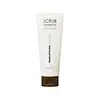What's inside
What's inside
 Key Ingredients
Key Ingredients

 Benefits
Benefits

 Concerns
Concerns

 Ingredients Side-by-side
Ingredients Side-by-side

Water
Skin ConditioningPerlite
AbsorbentAmmonium Laureth Sulfate
CleansingGlycerin
HumectantCocamidopropyl Betaine
CleansingAmmonium Lauryl Sulfate
CleansingAcrylates Copolymer
Sodium Chloride
MaskingMentha Arvensis Leaf Oil
MaskingDipropylene Glycol
HumectantSodium Benzoate
MaskingPotassium Hydroxide
BufferingHydroxyacetophenone
Antioxidant1,2-Hexanediol
Skin ConditioningButylene Glycol
HumectantAmmonium Sulfate
Laureth-3
EmulsifyingLauryl Alcohol
EmollientDisodium EDTA
Centella Asiatica Extract
CleansingPolygonum Cuspidatum Root Extract
AntioxidantScutellaria Baicalensis Root Extract
AstringentCamellia Sinensis Leaf Extract
AntimicrobialGlycyrrhiza Glabra Root Extract
BleachingChamomilla Recutita Flower Extract
MaskingRosmarinus Officinalis Leaf Extract
AntimicrobialLimonene
PerfumingWater, Perlite, Ammonium Laureth Sulfate, Glycerin, Cocamidopropyl Betaine, Ammonium Lauryl Sulfate, Acrylates Copolymer, Sodium Chloride, Mentha Arvensis Leaf Oil, Dipropylene Glycol, Sodium Benzoate, Potassium Hydroxide, Hydroxyacetophenone, 1,2-Hexanediol, Butylene Glycol, Ammonium Sulfate, Laureth-3, Lauryl Alcohol, Disodium EDTA, Centella Asiatica Extract, Polygonum Cuspidatum Root Extract, Scutellaria Baicalensis Root Extract, Camellia Sinensis Leaf Extract, Glycyrrhiza Glabra Root Extract, Chamomilla Recutita Flower Extract, Rosmarinus Officinalis Leaf Extract, Limonene
Sodium Chloride 36%
MaskingCocamidopropyl Betaine
CleansingCoco-Betaine
CleansingPotassium Cocoate
EmulsifyingCoco-Glucoside
Cleansing1,2-Hexanediol
Skin ConditioningCamellia Sinensis Leaf Extract
AntimicrobialCentella Asiatica Extract
CleansingMelaleuca Alternifolia Leaf Extract
PerfumingLavandula Angustifolia Extract
Skin ConditioningMentha Citrata Leaf Extract
AstringentMentha Piperita Leaf Extract
Skin ConditioningFreesia Refracta Extract
Skin ConditioningChamomilla Vulgaris Extract
Skin ProtectingRosmarinus Officinalis Leaf Extract
AntimicrobialPanthenol
Skin ConditioningIllicium Verum Fruit Extract
PerfumingScutellaria Baicalensis Extract
AntimicrobialButylene Glycol
HumectantGlycolic Acid
BufferingParfum
MaskingSodium Chloride 36%, Cocamidopropyl Betaine, Coco-Betaine, Potassium Cocoate, Coco-Glucoside, 1,2-Hexanediol, Camellia Sinensis Leaf Extract, Centella Asiatica Extract, Melaleuca Alternifolia Leaf Extract, Lavandula Angustifolia Extract, Mentha Citrata Leaf Extract, Mentha Piperita Leaf Extract, Freesia Refracta Extract, Chamomilla Vulgaris Extract, Rosmarinus Officinalis Leaf Extract, Panthenol, Illicium Verum Fruit Extract, Scutellaria Baicalensis Extract, Butylene Glycol, Glycolic Acid, Parfum
 Reviews
Reviews

Ingredients Explained
These ingredients are found in both products.
Ingredients higher up in an ingredient list are typically present in a larger amount.
1,2-Hexanediol is a synthetic liquid and another multi-functional powerhouse.
It is a:
- Humectant, drawing moisture into the skin
- Emollient, helping to soften skin
- Solvent, dispersing and stabilizing formulas
- Preservative booster, enhancing the antimicrobial activity of other preservatives
Butylene Glycol (or BG) is used within cosmetic products for a few different reasons:
Overall, Butylene Glycol is a safe and well-rounded ingredient that works well with other ingredients.
Though this ingredient works well with most skin types, some people with sensitive skin may experience a reaction such as allergic rashes, closed comedones, or itchiness.
Learn more about Butylene GlycolCamellia Sinensis Leaf Extract is derived from the leaves of the tea plant. Black tea, green tea, and oolong tea are all harvested from this plant.
This ingredient has many skin benefits:
This ingredient contains polyphenols, a strong antioxidant. Antioxidants help fight off molecules that damage skin cells.
On top of that, the antioxidants in green tea neutralize free-radicals from the sun. This gives the skin some extra UV protection, but should not replace sunscreen.
Many components of tea have anti-inflammatory properties.
Polyphenols and L-theanine help soothe the skin and reduce irritation. The caffeine in Camellia Sinensis Leaf Extract helps calm inflamed blood vessels.
Other compounds found in tea include: Vitamin Bs, linoleic acid, magnesium, calcium, iron, and zinc.
Research has shown both drinking Camellia Sinensis Leaf Tea and applying it to the skin can help boost skin elasticity and hydration. Studies also show using tea extract may reduce sebum, or oil, production.
Learn more about Camellia Sinensis Leaf ExtractCentella Asiatica Extract (Centella) is derived from an herb native to Southeast Asia. It is famous for its anti-inflammatory and soothing properties.
Centella is rich in antioxidants and amino acids, such as Madecassic Acid and Asiaticoside.
Studies show the compounds in centella help with:
The combination of all these properties makes centella effective at soothing, hydrating, and protecting the skin.
Other great components of centella include Vitamin A, vitamin C, several B vitamins, and Asiatic Acid.
Fun fact: Centella has been used as a medicine and in food for many centuries. As a medicine, it is used to treat burns, scratches, and wounds.
Learn more about Centella Asiatica ExtractCocamidopropyl Betaine is a fatty acid created by mixing similar compounds in coconut oil and dimethylaminopropylamine, a compound with two amino groups.
This ingredient is a surfactant and cleanser. It helps gather the dirt, pollutants, and other impurities in your skin to be washed away. It also helps thicken a product and make the texture more creamy.
Being created from coconut oil means Cocamidopropyl Betaine is hydrating for the skin.
While Cocamidopropyl Betaine was believed to be an allergen, a study from 2012 disproved this. It found two compounds in unpure Cocamidopropyl Betaine to be the irritants: aminoamide and 3-dimethylaminopropylamine. High-grade and pure Cocamidopropyl Betaine did not induce allergic reactions during this study.
Learn more about Cocamidopropyl BetaineRosmarinus Officinalis Leaf Extract comes from rosemary. Rosemary is native to the Mediterranean.
While Rosmarinus Officinalis Leaf Oil can be volatile due to its fragrant properties, the fragrance components are usually removed in the leaf extract.
Rosemary Leaf Extract contains many antioxidants such as rosmarinic acid and caffeic acid. Rosemarinic acid, a compound found in rosemary leaf, has been found to help soothe skin conditions such as eczema and acne.
Learn more about Rosmarinus Officinalis Leaf ExtractChances are, you eat sodium chloride every day. Sodium Chloride is also known as table salt.
This ingredient has many purposes in skincare: thickener, emulsifier, and exfoliator.
You'll most likely find this ingredient in cleansers where it is used to create a gel-like texture. As an emulsifier, it also prevents ingredients from separating.
There is much debate on whether this ingredient is comedogenic. The short answer - comedogenic ratings don't tell the whole story. Learn more about comegodenic ratings here.
The concensus about this ingredient causing acne seems to be divided. Research is needed to understand if this ingredient does cause acne.
Scrubs may use salt as the primary exfoliating ingredient.
Learn more about Sodium Chloride